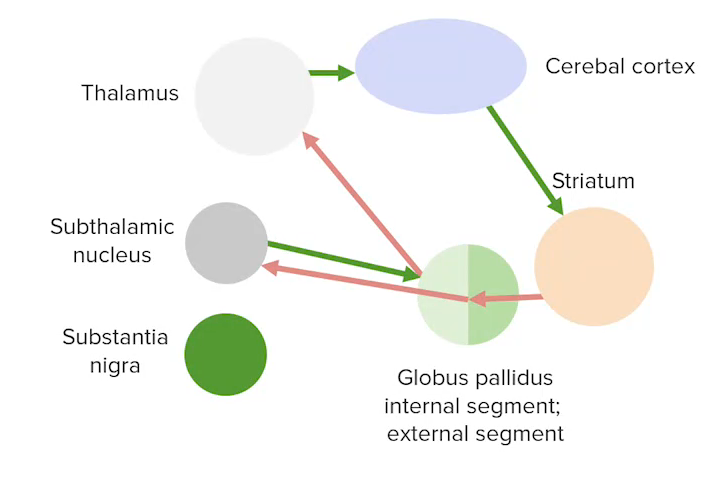Playlist
Show Playlist
Hide Playlist
Structures and Intrinsic Connections of the Basal Ganglia
-
Slides 14 BasalGanglia BrainAndNervousSystem.pdf
-
Reference List Anatomy.pdf
-
Download Lecture Overview
00:00 Welcome to this presentation on the basal ganglia. The first thing that I would like you to make note of is what are the major structures that constitute the basal ganglia. First, we have two structures that collectively constitute the striatum. One of those members is the caudate nucleus that we see here in the lateral aspect of the lateral ventricle. Then the second member of the striatum is the putamen that you see labeled next on this image. Another member of the basal ganglia would be the globus pallidus. It has two segments, an internal segment shown in through here as well as an external segment or division shown here. I will now take you to another image to show you yet another member of the basal ganglia. This is the substantia nigra, the black substance that resides in the midbrain. You can see the substantia nigra right in through here as well as over in through here on the opposite side. The last member of the basal ganglia is the subthalamic nucleus. However, that is not shown. This is a great three dimensional image showing the topographic relationships of the basal ganglia. The first thing to point out here is not a member of the basal ganglia but the lateral ventricle. Here’s your lateral ventricle in through here, coming down in through here and into the temporal area in through here. The basal ganglia that are shown in this representation include the caudate nucleus. We can see its relationship then to the putamen. And then lastly, we can see the relationship of these two structures to the globus pallidus. Now, this takes us to a more complicated aspect of the basal ganglia. 02:31 This would be the intrinsic connections or the circuitry that exists between the components of the basal ganglia as well as the thalamus and the cerebral cortex. So you see various brain structures identified over in through here. So now, I will guide you through these connections. 02:58 First is the striatopallidal connection that we have between the members of the striatum with the globus pallidus. These fibers are inhibitory as they are GABAergic. We also have a pathway between the striatum and the substantia nigra. This is the striatonigral pathway. 03:23 We see that pathway extending from the striatum to the substantia nigra. That is also inhibitory and is GABAergic. The globus pallidus, its external segment connects with the subthalamus. 03:43 So we see that connection right in through here. This is also inhibitory and that it’s GABAergic. 03:54 Subthalamic output to the substantia nigra is shown here in this connection. 04:08 This is an excitatory pathway in that it is glutamatergic. Then the last consideration is the connection that exists between the substantia nigra and the striatum. We see that connection here. This is going to be dopaminergic, so dopamine is the neurotransmitter.
About the Lecture
The lecture Structures and Intrinsic Connections of the Basal Ganglia by Craig Canby, PhD is from the course Basal Ganglia. It contains the following chapters:
- Basal Ganglia – Major Structures
- Basal Ganglia – Intrinsic Connections
Included Quiz Questions
Which of the following combine to form the dorsal striatum?
- Caudate and putamen nucleus
- Subthalamic nucleus and substantia nigra
- Putamen and subthalamic nucleus
- Globus pallidus externus and globus pallidus internus
- Caudate and globus pallidus
Where is the only intrinsic dopaminergic connection of basal ganglia seen?
- Substantia nigra to striatum
- Globus pallidus externus to subthalamic nucleus
- Subthalamic nucleus to substantia nigra
- Striatum to substantia nigra
- Striatum to globus pallidus
Customer reviews
2,0 of 5 stars
| 5 Stars |
|
1 |
| 4 Stars |
|
0 |
| 3 Stars |
|
1 |
| 2 Stars |
|
0 |
| 1 Star |
|
4 |
not enough detail to understand the topic. Renders and slides could also use work for this whole section, they arent sufficient to give an understanding of the section and understand structures of the brain in relation to each other.
I'm just curious whether this professor recites what he is reading and points out what's on the diagrams.
Poorly information of the basal ganglia and the system of the basal ganglia was not set up very well
A good overview of the topic that in my opinion covers the main ideas regarding the basal ganglia along with a good clinical correlation.




